最新最全少儿英语DEMO课的教案(1)完整版
- 格式:pdf
- 大小:1.21 MB
- 文档页数:1
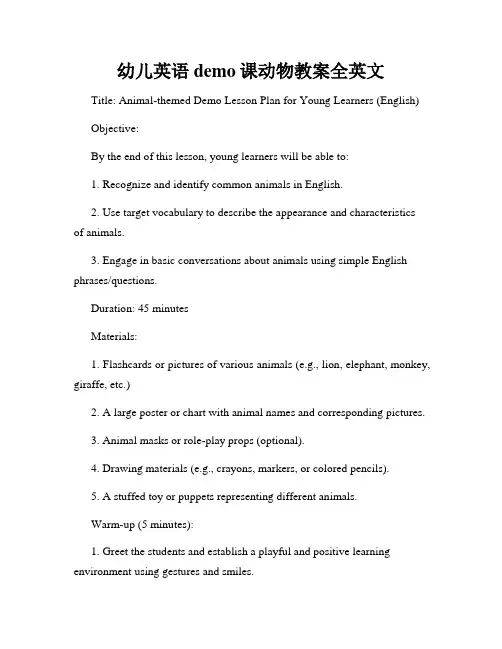
幼儿英语demo课动物教案全英文Title: Animal-themed Demo Lesson Plan for Young Learners (English)Objective:By the end of this lesson, young learners will be able to:1. Recognize and identify common animals in English.2. Use target vocabulary to describe the appearance and characteristicsof animals.3. Engage in basic conversations about animals using simple English phrases/questions.Duration: 45 minutesMaterials:1. Flashcards or pictures of various animals (e.g., lion, elephant, monkey, giraffe, etc.)2. A large poster or chart with animal names and corresponding pictures.3. Animal masks or role-play props (optional).4. Drawing materials (e.g., crayons, markers, or colored pencils).5. A stuffed toy or puppets representing different animals.Warm-up (5 minutes):1. Greet the students and establish a playful and positive learning environment using gestures and smiles.2. Sing a popular children's song about animals, such as "Old MacDonald Had a Farm," to pre-introduce the topic. Encourage the children to sing along and make animal sounds.Introduction (10 minutes):1. Present the flashcards/pictures of different animals.2. Elicit the names of the animals from the students and repeat the words together.3. Use the poster or chart to show the names of each animal, pointing to the corresponding picture as you say the word.4. Distribute animal masks or props for the students to wear or hold, creating a fun and engaging atmosphere.Vocabulary and Language Practice (15 minutes):1. Hold up one of the flashcards or pictures and ask the students, "What animal is this?"2. Once they respond, provide the correct answer and model the pronunciation.3. Show the picture to the class again and ask questions like, "What sound does it make?" or "What color is it?"4. Encourage the students to repeat the questions and answers, both individually and as a group.5. Use the stuffed toy or puppets to act out a brief conversation between animals, modeling simple English phrases and questions for the students to imitate.Activity (15 minutes):1. Divide the students into pairs or small groups.2. Distribute drawing materials and assign each group an animal.3. Instruct the students to take turns describing and drawing their assigned animal, using the target vocabulary and phrases they have learned.4. Circulate among the groups, offering assistance and feedback as needed.5. After a designated time, invite each group to present their drawings and descriptions to the class.Closure (5 minutes):1. Review the names of the animals, using the flashcards or pictures.2. Encourage the students to recap what they have learned about their assigned animal during the activity.3. Sing the animal song from the warm-up activity again, allowing the students to actively participate and demonstrate their knowledge.Extension Activity (optional):1. Provide coloring worksheets with different animal images.2. Instruct the students to color the animals and label them with the corresponding name in English.3. Display the completed worksheets on the classroom walls for further reinforcement and visual reference.Notes:- Adapt the level of difficulty and complexity based on the age and language proficiency of the students.- Use gestures, visuals, and actions to support comprehension throughout the lesson.- Encourage active participation from all students by incorporating opportunities for speaking, listening, and creative expression.- Provide continuous positive reinforcement and create an inclusive and supportive learning environment.。
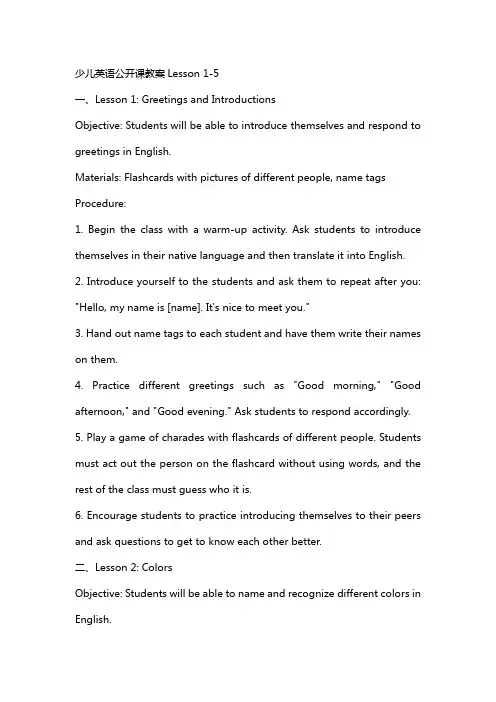
少儿英语公开课教案Lesson 1-5一、Lesson 1: Greetings and IntroductionsObjective: Students will be able to introduce themselves and respond to greetings in English.Materials: Flashcards with pictures of different people, name tags Procedure:1. Begin the class with a warm-up activity. Ask students to introduce themselves in their native language and then translate it into English.2. Introduce yourself to the students and ask them to repeat after you: "Hello, my name is [name]. It's nice to meet you."3. Hand out name tags to each student and have them write their names on them.4. Practice different greetings such as "Good morning," "Good afternoon," and "Good evening." Ask students to respond accordingly.5. Play a game of charades with flashcards of different people. Students must act out the person on the flashcard without using words, and the rest of the class must guess who it is.6. Encourage students to practice introducing themselves to their peers and ask questions to get to know each other better.二、Lesson 2: ColorsObjective: Students will be able to name and recognize different colors in English.Materials: Flashcards with colors, color wheel, crayons and paper Procedure:1. Begin the class asking students to name the colors of the objects in the classroom.2. Introduce the color wheel and go through each color, saying the English word and asking students to repeat after you.3. Hand out flashcards with colors on them and have students match the flashcard to the correct color on the color wheel.4. Give each student a piece of paper and crayons, and ask them to drawa picture using the colors they have learned.5. Encourage students to practice naming colors in English and ask them to find objects in the classroom that match the colors on their flashcards.三、Lesson 3: Numbers 1-10Objective: Students will be able to count from 1 to 10 in English. Materials: Number flashcards, objects to count (e.g., buttons, coins) Procedure:1. Begin the class asking students to count in their native language.2. Introduce the numbers 1-10 in English and have students repeat after you.3. Hand out number flashcards and have students match the number to the correct number of objects.4. Practice counting objects in the classroom, such as buttons, coins, orchrs.5. Play a game of "Simon Says" where the teacher says a number, and students must touch that number of objects.6. Encourage students to practice counting in English and ask them to find objects in the classroom to count.四、Lesson 4: AlphabetObjective: Students will be able to recognize and name the letters of the English alphabet.Materials: Alphabet flashcards, alphabet chartProcedure:1. Begin the class singing the "Alphabet Song" to familiarize students with the letters of the alphabet.2. Introduce each letter of the alphabet using flashcards and have students repeat after you.3. Hang an alphabet chart on the wall and point to each letter, asking students to name it.4. Practice tracing the letters of the alphabet with your finger or a pointer, and have students follow along.5. Play a game of "Memory" with alphabet flashcards. Place the flashcards face down on the table, and students must flip over two cards at a time to find matching letters.6. Encourage students to practice naming the letters of the alphabet inEnglish and ask them to find objects in the classroom that start with each letter.五、Lesson 5: Simple SentencesObjective: Students will be able to construct and understand simple sentences in English.Materials: Flashcards with pictures, sentence stripsProcedure:1. Begin the class asking students to form simple sentences in their native language.2. Introduce the concept of simple sentences in English, explning that a simple sentence consists of a subject, verb, and object.3. Hand out flashcards with pictures on them and have students create a simple sentence using the words "I," "like," and "ice cream."4. Practice using different subjects and verbs to create simple sentences, such as "She," "likes," and "dancing."5. Give each student a sentence strip with a simple sentence on it, and ask them to find the subject,六、Lesson 6: Family and FriendsObjective: Students will be able to name family members and friends in English.Materials: Flashcards with family and friend pictures, family tree diagram Procedure:1. Begin the class asking students to name their family members and friends in their native language.2. Introduce the names of family members and friends in English, such as mother, father, sister, brother, friend, etc.3. Hand out flashcards with family and friend pictures on them and have students match the flashcard to the correct name.4. Create a family tree diagram on the board or a large sheet of paper, and ask students to identify and label their family members and friends.5. Practice asking and answering questions about family and friends, such as "Do you have a brother?" or "What is your mother's name?"6. Encourage students to practice naming family members and friends in English and ask them to share information about their family and friends with their peers.七、Lesson 7: AnimalsObjective: Students will be able to name and describe different animals in English.Materials: Flashcards with animal pictures, animal sounds chart Procedure:1. Begin the class asking students to name animals in their native language.2. Introduce the names of different animals in English, showing them the flashcards with animal pictures on them.3. Practice making the sounds that each animal makes, and have students imitate the sounds.4. Hand out an animal sounds chart and ask students to circle the animal sounds they hear.5. Play a game of charades with animal flashcards. Students must act out the animal without using words, and the rest of the class must guess which animal it is.6. Encourage students to practice naming and describing animals in English and ask them to find pictures of their favorite animals to bring to class.八、Lesson 8: Food and DrinkObjective: Students will be able to name and describe different foods and drinks in English.Materials: Flashcards with food and drink pictures, food and drink menu Procedure:1. Begin the class asking students to name foods and drinks in their native language.2. Introduce the names of different foods and drinks in English, showing them the flashcards with food and drink pictures on them.3. Practice ordering food and drinks in English, using phrases such as "I would like," "please," and "thank you."4. Hand out a food and drink menu and ask students to circle the itemsthey would like to order.5. Play a game of "Memory" with food and drink flashcards. Place the flashcards face down on the table, and students must flip over two cards at a time to find matching items.6. Encourage students to practice naming and describing foods and drinks in English and ask them to bring a picture of their favorite food or drink to class.九、Lesson 9: ClothingObjective: Students will be able to name and describe different articles of clothing in English.Materials: Flashcards with clothing pictures, clothing sorting activity Procedure:1. Begin the class asking students to name articles of clothing in their native language.2. Introduce the names of different articles of clothing in English, showing them the flashcards with clothing pictures on them.3. Hand out a clothing sorting activity where students must match the clothing items to the correct category (e.g., tops, bottoms, shoes, accessories).4. Practice asking and answering questions about clothing, such as "What is your favorite color of shirt?" or "Do you like to wear jeans or shorts?"5. Play a game of charades with clothing flashcards. Students must act out the article of clothing without using words, and the rest of the class must guess which item it is.6. Encourage students to practice naming and describing articles of clothing in English and ask them to bring a picture of their favorite outfit to class.十、Lesson 10: Review and AssessmentObjective: Students will demonstrate their understanding of the concepts covered in the past ten lessons.Materials: Review worksheets, flashcards, assessment checklist Procedure:1. Begin the class reviewing the concepts covered in the past ten lessons, such as greetings, colors, numbers, alphabet, family and friends, animals, food and drink, clothing, and simple sentences.2. Hand out review worksheets where students must plete tasks related to the concepts learned, such as fill in the blank, matching, or crossword puzzles.3. Conduct a mini-ass十一、Lesson 11: Days of the WeekObjective: Students will be able to name and recognize the days of the week in English.Materials: Days of the week flashcards, calendarProcedure:1. Begin the class asking students to name the days of the week in their native language.2. Introduce the days of the week in English, showing them the flashcards with the days of the week on them.3. Hand out a calendar and ask students to circle the current day of the week.4. Practice reciting the days of the week in English, and have students repeat after you.5. Play a game of "Simon Says" where the teacher says a day of the week, and students must touch that day on the calendar.6. Encourage students to practice naming the days of the week in English and ask them to find objects in the classroom that represent each day. 十二、Lesson 12: Months and SeasonsObjective: Students will be able to name and recognize the months and seasons in English.Materials: Months and seasons flashcards, seasonal pictures Procedure:1. Begin the class asking students to name the months and seasons in their native language.2. Introduce the months and seasons in English, showing them the flashcards with the months and seasons on them.3. Hand out a calendar and ask students to circle the current month and season.4. Practice reciting the months and seasons in English, and have students repeat after you.5. Display seasonal pictures around the classroom, and ask students to identify the season each picture represents.6. Encourage students to practice naming the months and seasons in English and ask them to discuss their favorite season and why.十三、Lesson 13: TimeObjective: Students will be able to tell the time in English using simple phrases.Materials: Clock diagram, digital clock, time phrases flashcards Procedure:1. Begin the class asking students to tell the time in their native language.2. Introduce the concept of time in English, explning that telling time involves hours and minutes.3. Hand out a clock diagram and ask students to identify the current time.4. Practice using simple time phrases in English, such as "It's 3 o'clock" or "It's 2:30."5. Display a digital clock in the classroom, and ask students to practicetelling the time aloud.6. Encourage students to practice telling the time in English and ask them to set a timer for a short duration, such as 5 minutes.十四、Lesson 14: Countries and ContinentsObjective: Students will be able to name and recognize different countries and continents in English.Materials: Maps of the world, flashcards with country and continent namesProcedure:1. Begin the class asking students to name some countries and continents in their native language.2. Introduce the names of different countries and continents in English, showing them the flashcards with country and continent names on them.3. Hand out maps of the world and ask students to locate and circle the countries and continents they have learned.4. Practice naming countries and continents in English, and have students repeat after you.5. Display a world map in the classroom, and ask students to point to the countries and continents they have learned.6. Encourage students to practice naming countries and continents in English and ask them to share something interesting about a country or continent they have learned.十五、Lesson 15: Review and AssessmentObjective: Students will demonstrate their understanding of the concepts covered in the past fifteen lessons.Materials: Review worksheets, flashcards, assessment checklist Procedure:1. Begin the class reviewing the concepts covered in the past fifteen lessons, such as greetings, colors, numbers, alphabet, family and friends, animals, food and drink, clothing, days of the week, months and seasons, time, countries and continents, and simple sentences.2. Hand out review worksheets where students must plete tasks related to the concepts learned, such as fill in the blank, matching, or crossword puzzles.3. Conduct a mini-assessment to evaluate students' understanding of the concepts covered. This can be done through a written or oral assessment, depending on the students' level.4. Provide feedback and encouragement to students based on their performance, and identify areas that need further practice.5. Plan additional activities or lessons to address any areas of weakness identified during the assessment.6. Celebrate the重点和难点解析一、Lesson 1: Greetings and Introductions重点:学习如何用英语进行问候和介绍。
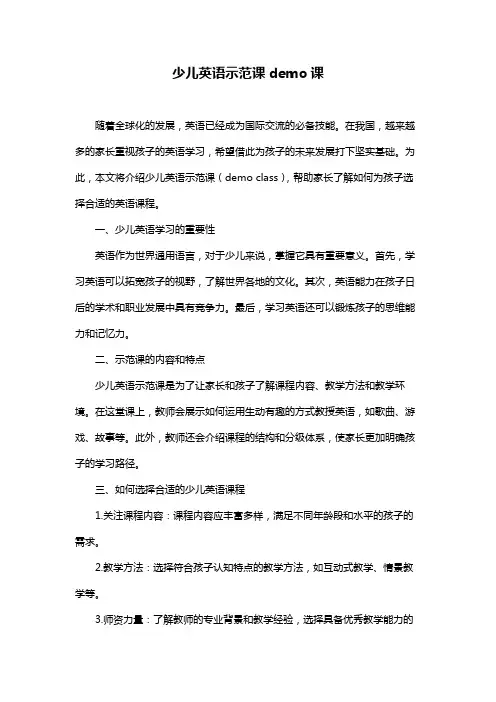
少儿英语示范课demo课随着全球化的发展,英语已经成为国际交流的必备技能。
在我国,越来越多的家长重视孩子的英语学习,希望借此为孩子的未来发展打下坚实基础。
为此,本文将介绍少儿英语示范课(demo class),帮助家长了解如何为孩子选择合适的英语课程。
一、少儿英语学习的重要性英语作为世界通用语言,对于少儿来说,掌握它具有重要意义。
首先,学习英语可以拓宽孩子的视野,了解世界各地的文化。
其次,英语能力在孩子日后的学术和职业发展中具有竞争力。
最后,学习英语还可以锻炼孩子的思维能力和记忆力。
二、示范课的内容和特点少儿英语示范课是为了让家长和孩子了解课程内容、教学方法和教学环境。
在这堂课上,教师会展示如何运用生动有趣的方式教授英语,如歌曲、游戏、故事等。
此外,教师还会介绍课程的结构和分级体系,使家长更加明确孩子的学习路径。
三、如何选择合适的少儿英语课程1.关注课程内容:课程内容应丰富多样,满足不同年龄段和水平的孩子的需求。
2.教学方法:选择符合孩子认知特点的教学方法,如互动式教学、情景教学等。
3.师资力量:了解教师的专业背景和教学经验,选择具备优秀教学能力的师资团队。
4.学习环境:环境舒适、设施齐全的学习环境有助于孩子更好地投入英语学习。
5.口碑和评价:参考其他家长和孩子的评价,了解课程的真实情况。
四、家长在孩子英语学习中的角色1.激发孩子学习兴趣:家长可以通过陪伴学习、参与课堂活动等方式,激发孩子对英语的兴趣。
2.监督学习进度:家长应关注孩子的学习进度,适时调整学习计划。
3.创设语言环境:家长可以为孩子营造一个良好的英语学习氛围,如看英文动画片、听英文歌曲等。
4.鼓励与表扬:在孩子学习英语的过程中,家长应给予充分的鼓励和表扬,增强孩子的自信心。
五、总结少儿英语示范课是家长了解英语课程的重要途径。
通过选择合适的课程,家长可以为孩子提供优质的教育资源,助力孩子英语学习。
同时,家长在孩子英语学习过程中的陪伴和引导也至关重要。

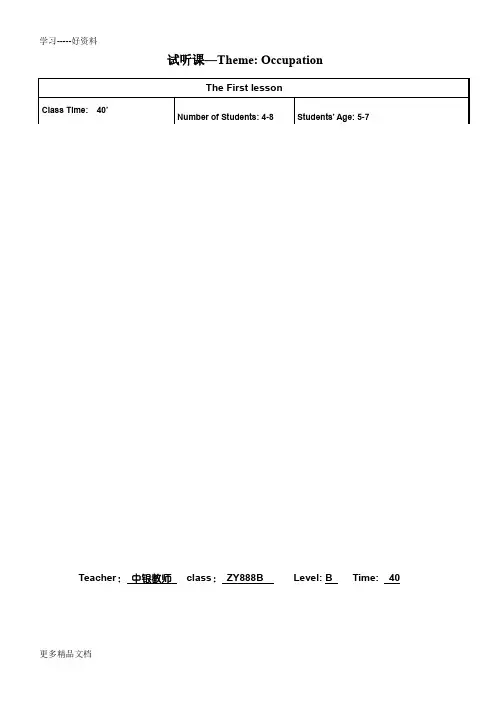

少儿英语公开课教案Lesson 1-5一、Lesson 1: Greetings and IntroductionsObjective:1. Students will be able to introduce themselves and greet others in English.2. Students will learn basic phrases for asking and responding to questions about their names, ages, and favorite colors.Materials:1. Flashcards with pictures of different colors2. Name tagsProcedure:1. Begin the lesson with a warm-up activity, such as a simple song or dance to get the students engaged.2. Introduce yourself and ask the students to introduce themselves. Model the correct phrases and pronunciation.3. Distribute name tags to the students and have them wear them for the duration of the lesson.4. Display the flashcards with pictures of different colors and ask the students to identify the colors.5. Practice asking and responding to questions about names, ages, and favorite colors. Encourage the students to ask each other these questions.6. Conduct a role-play activity where the students practice introducing themselves and asking questions to their classmates.7. End the lesson with a fun game, such as "Simon Says" using color names in English.二、Lesson 2: Alphabet RecognitionObjective:1. Students will be able to recognize and name the letters of the English alphabet.2. Students will learn the correct pronunciation of each letter. Materials:1. Large alphabet letters displayed on flashcards2. Worksheet with pictures of objects that start with each letter of the alphabetProcedure:1. Begin the lesson singing the "Alphabet Song" to familiarize the students with the letters of the alphabet.2. Display the large alphabet letters on flashcards and have the students repeat the letters and their pronunciations.3. Practice tracing the letters of the alphabet on a large whiteboard or blackboard.4. Hand out the worksheets and have the students circle the objects that start with each letter of the alphabet.5. Conduct a group activity where the students take turns naming objects that start with each letter of the alphabet.6. End the lesson with a fun game, such as "Memory Match" using alphabet letters as cards.三、Lesson 3: Numbers and CountingObjective:1. Students will be able to count from 1 to 20 in English.2. Students will learn to recognize and write numbers 1-20. Materials:1. Number flashcards2. Counters or small objects to represent numbersProcedure:1. Begin the lesson introducing the concept of numbers and counting.2. Display the number flashcards and have the students repeat the numbers and their pronunciations.3. Practice counting with the students, using counters or small objects to represent the numbers.4. Hand out worksheets with number lines and have the students fill in the missing numbers.5. Conduct a group activity where the students take turns counting objects in the classroom, such as chrs or desks.6. End the lesson with a fun game, such as "Number Memory" usingnumber cards.四、Lesson 4: Simple Sentences and QuestionsObjective:1. Students will be able to construct simple sentences in English.2. Students will learn to ask and answer questions using simple sentence structure.Materials:1. Flashcards with pictures of everyday objects2. Worksheet with sentences to pleteProcedure:1. Begin the lesson introducing the concept of simple sentences and questions.2. Display the flashcards with pictures of everyday objects and have the students name the objects.3. Practice constructing simple sentences using the objects, such as "This is a book" or "She has a pen."4. Introduce question words, such as "What is this?" or "Who has a pen?" and have the students ask and answer questions using simple sentence structure.5. Hand out the worksheets and have the students plete the sentences using the pictures provided.6. Conduct a group activity where the students take turns asking andanswering questions using simple sentence structure.7. End the lesson with a fun game, such as "Charades" using simple sentences as clues.五、Lesson 5: Days of the Week and MonthsObjective:1. Students will be able to name the days of the week and months in English.2. Students will learn the correct order of the days and months. Materials:1. Flashcards with pictures of the days of the六、Lesson 6: Colors and ShapesObjective:1. Students will be able to name and recognize different colors and shapes in English.2. Students will learn to describe objects using color and shape adjectives.Materials:1. Flashcards with pictures of different colors and shapes2. Colored objects or shapesProcedure:1. Begin the lesson reviewing the colors and shapes learned in previous lessons.have the students name them.3. Practice describing objects using color and shape adjectives, such as "The circle is red" or "The square is blue."4. Hand out colored objects or shapes and have the students practice describing them.5. Conduct a group activity where the students take turns finding objects in the classroom that match the given color or shape.6. End the lesson with a fun game, such as "Color and Shape Memory" using color and shape cards.七、Lesson 7: Animal Names and SoundsObjective:1. Students will be able to name and imitate the sounds of different animals in English.2. Students will learn to associate animal names with their corresponding sounds.Materials:1. Flashcards with pictures of different animals2.玩具动物声音Procedure:1. Begin the lesson introducing the concept of animal names and sounds.students name them.3. Play the toy animal sounds and have the students guess which animal it is.4. Practice imitating the sounds of different animals and associating them with their names, such as "The dog says 'Woof!'" or "The cat says 'Meow!'"5. Hand out small toy animals and have the students practice making their sounds.6. Conduct a group activity where the students take turns bringing out a toy animal and having the others guess its name and sound.7. End the lesson with a fun game, such as "Animal Charades" using animal names and sounds as clues.八、Lesson 8: Family and FriendsObjective:1. Students will be able to name and describe their family and friends in English.2. Students will learn to use possessive pronouns and adjectives to talk about their loved ones.Materials:1. Flashcards with pictures of family members and friends2. Worksheet with sentences to pleteProcedure:1. Begin the lesson introducing the concept of family and friends.2. Display the flashcards with pictures of family members and friends and have the students name them.3. Practice using possessive pronouns and adjectives to describe their family and friends, such as "This is my mother" or "She is my best friend."4. Hand out the worksheets and have the students plete the sentences using the pictures provided.5. Conduct a group activity where the students take turns sharing information about their family and friends.6. End the lesson with a fun game, such as "Guess Who?" using pictures of students' family members and friends as clues.九、Lesson 9: Actions and VerbsObjective:1. Students will be able to name and describe different actions and activities in English.2. Students will learn to use action words (verbs) to describe what people are doing.Materials:1. Flashcards with pictures of different actions and activities2. Action figures or dollsProcedure:1. Begin the lesson introducing the concept of actions and verbs.2. Display the flashcards with pictures of different actions and activities and have the students name them.3. Practice using action words (verbs) to describe what people are doing in each picture, such as "She is running" or "He is jumping."4. Hand out action figures or dolls and have the students practice acting out the actions and using the corresponding verbs.5. Conduct a group activity where the students take turns acting out actions and having the others guess what they are doing.6. End the lesson with a fun game, such as "Action Charades" using action words as clues.十、Lesson 10: Review and AssessmentObjective:1. Students will demonstrate their understanding of the concepts and skills learned throughout the course.2. Students will improve their speaking, listening, reading, and writing skills through a variety of review activities.Materials:1. Review worksheet with a variety of activities2. Assessment tools, such重点和难点解析一、Lesson 1: Greetings and Introductions重点关注环节:1. 学生自我介绍和问候他人的正确phrases 和发音。
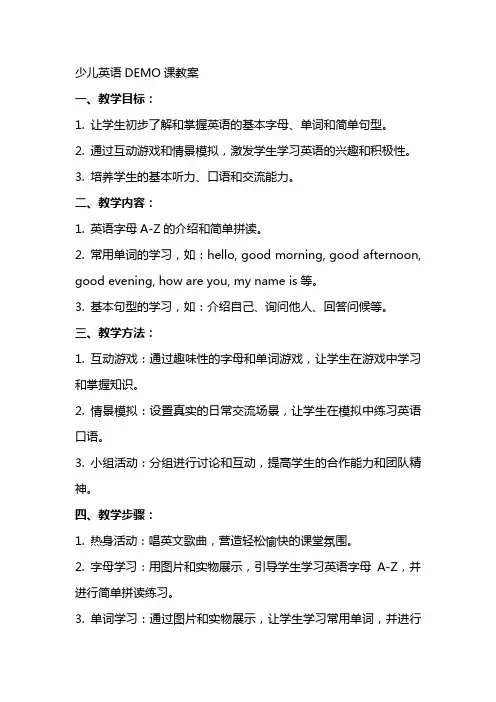
少儿英语DEMO课教案一、教学目标:1. 让学生初步了解和掌握英语的基本字母、单词和简单句型。
2. 通过互动游戏和情景模拟,激发学生学习英语的兴趣和积极性。
3. 培养学生的基本听力、口语和交流能力。
二、教学内容:1. 英语字母A-Z的介绍和简单拼读。
2. 常用单词的学习,如:hello, good morning, good afternoon, good evening, how are you, my name is等。
3. 基本句型的学习,如:介绍自己、询问他人、回答问候等。
三、教学方法:1. 互动游戏:通过趣味性的字母和单词游戏,让学生在游戏中学习和掌握知识。
2. 情景模拟:设置真实的日常交流场景,让学生在模拟中练习英语口语。
3. 小组活动:分组进行讨论和互动,提高学生的合作能力和团队精神。
四、教学步骤:1. 热身活动:唱英文歌曲,营造轻松愉快的课堂氛围。
2. 字母学习:用图片和实物展示,引导学生学习英语字母A-Z,并进行简单拼读练习。
3. 单词学习:通过图片和实物展示,让学生学习常用单词,并进行听力练习。
4. 句型学习:用情景模拟的方式,让学生练习基本句型,如介绍自己、询问他人等。
5. 互动游戏:组织学生进行趣味性的字母和单词游戏,巩固所学知识。
五、作业布置:1. 复习所学的字母、单词和句型。
2. 家长签字确认学生的学习情况。
3. 鼓励学生在家进行英语口语练习,提高听力、口语能力。
六、教学评估:1. 观察学生在课堂上的参与程度和表现,了解他们的学习兴趣和积极性。
2. 通过听力练习和口语练习,评估学生的基本听力、口语能力。
3. 收集学生的作业,评估他们的学习效果和掌握程度。
七、教学资源:1. PPT课件:包含字母、单词、句型的介绍和练习。
2. 图片和实物:用于辅助教学,让学生更直观地学习和理解。
3. 听力材料:包括音频和视频,用于提高学生的听力能力。
4. 作业模板:用于布置和收集学生的作业。
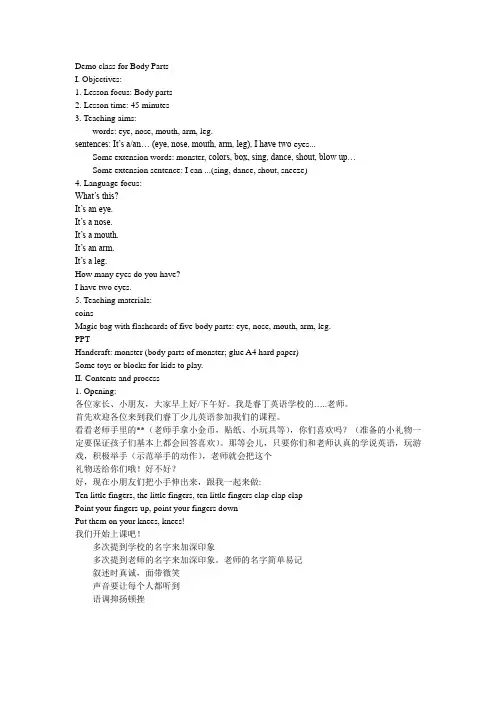

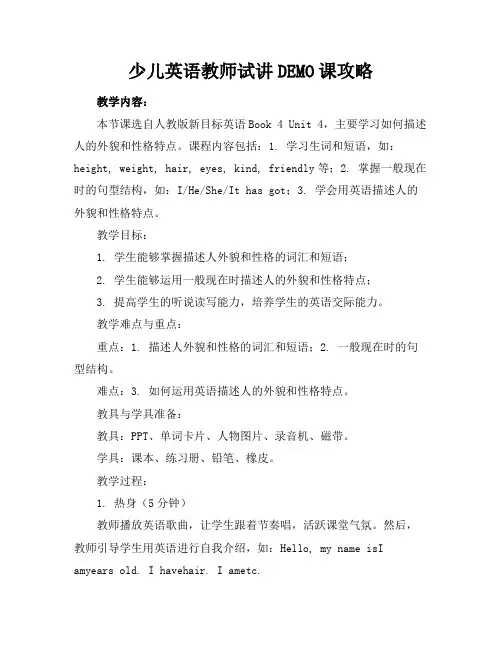
少儿英语教师试讲DEMO课攻略教学内容:本节课选自人教版新目标英语Book 4 Unit 4,主要学习如何描述人的外貌和性格特点。
课程内容包括:1. 学习生词和短语,如:height, weight, hair, eyes, kind, friendly等;2. 掌握一般现在时的句型结构,如:I/He/She/It has got;3. 学会用英语描述人的外貌和性格特点。
教学目标:1. 学生能够掌握描述人外貌和性格的词汇和短语;2. 学生能够运用一般现在时描述人的外貌和性格特点;3. 提高学生的听说读写能力,培养学生的英语交际能力。
教学难点与重点:重点:1. 描述人外貌和性格的词汇和短语;2. 一般现在时的句型结构。
难点:3. 如何运用英语描述人的外貌和性格特点。
教具与学具准备:教具:PPT、单词卡片、人物图片、录音机、磁带。
学具:课本、练习册、铅笔、橡皮。
教学过程:1. 热身(5分钟)教师播放英语歌曲,让学生跟着节奏唱,活跃课堂气氛。
然后,教师引导学生用英语进行自我介绍,如:Hello, my name isI amyears old. I havehair. I ametc.2. 引入(10分钟)教师向学生介绍本节课的主要内容:描述人的外貌和性格特点。
通过展示人物图片,让学生猜测人物的外貌和性格特点,引发学生对主题的兴趣。
3. 呈现(15分钟)教师通过PPT展示生词和短语,如:height, weight, hair, eyes, kind, friendly等。
引导学生跟读,解释词义,并进行相应的练习。
4. 操练(10分钟)教师组织学生进行小组活动,让学生用英语描述自己或同伴的外貌和性格特点。
鼓励学生大胆开口,提高口语表达能力。
5. 巩固(10分钟)教师出示人物图片,让学生用英语描述人物的外貌和性格特点。
然后,让学生听录音,跟读,巩固所学内容。
6. 作业布置(5分钟)教师布置作业:1. 抄写生词和短语;2. 用英语写一篇关于自己或同伴的外貌和性格特点的短文。

少儿英语示范课demo课【原创版】目录1.少儿英语示范课的重要性2.少儿英语示范课的内容3.少儿英语示范课的实际应用4.少儿英语示范课的未来发展正文随着全球化的不断深入,英语已经成为了世界范围内最重要的交流语言。
而对于我国的少年儿童来说,学习英语的重要性更是不言而喻。
在这个大背景下,少儿英语示范课应运而生,成为了孩子们学习英语的重要途径。
少儿英语示范课的重要性主要体现在以下几个方面。
首先,它可以帮助孩子们建立起学习英语的兴趣,让他们在愉悦的氛围中学习英语。
其次,它可以帮助孩子们掌握英语的基本语法和词汇,为他们今后的英语学习打下坚实的基础。
最后,通过少儿英语示范课的学习,孩子们可以提高自己的英语听说能力,更好地适应未来社会的需求。
少儿英语示范课的内容主要包括英语的基本语法、词汇和听说训练。
在语法方面,示范课通常会从简单的句子结构和时态入手,逐步引导孩子们掌握英语的基本语法规则。
在词汇方面,示范课通常会以主题的形式进行,如颜色、动物、家庭等,帮助孩子们记忆相关词汇。
在听说训练方面,示范课通常会通过情景对话、角色扮演等方式,让孩子们在实际应用中提高自己的英语听说能力。
少儿英语示范课的实际应用主要体现在课堂教学和家庭教育两个方面。
在课堂教学中,教师可以通过示范课的方式,引导孩子们积极参与英语学习,提高他们的学习兴趣和效果。
在家庭教育中,家长可以通过陪孩子观看少儿英语示范课的视频,帮助孩子巩固课堂所学,提高他们的英语听说能力。
随着科技的发展,少儿英语示范课的未来发展前景广阔。
一方面,随着网络的普及,少儿英语示范课可以以网络课程的形式存在,让孩子们随时随地进行学习。
另一方面,随着人工智能技术的发展,少儿英语示范课可以结合人工智能,如通过智能语音助手进行听说训练,通过虚拟现实技术进行情景对话等,让孩子们在更真实的环境中学习英语。
总的来说,少儿英语示范课对于孩子们的英语学习具有重要的作用。
Teaching Aims:New words: To learn to read and recognize 3 kinds of colors: yellow, blue, pink. Sentence pattern: Try to answer “---What color is it?” using “---It is (color)....”To arouse kids’ interests in learning English.Teaching Materials:Flashcards, hammers, 3 kinds of colors, 3 bottles, magic wand and hat. Teaching Procedures:Warming-up:Greet the kids with a big smile and say --“Hello everyone” --“Hello Louie”, high five with the kids one by one.OK, follow Louie to do some actions: touch your head,touch your shoulders, touch your knees, touch your toes.Then let’s sing a song (Head and Shoulders.) to cheer them up.Words teaching:(1)Leading-in and presentation:(Draw a rainbow on the whiteboard).Look at the board, Wow, what is this? Yeah, a rainbow, let’s count how many colors, red, blue, green, pink, purple... Today we are going to learn some words about colors.(Take out a bottle of water.)Look at this bottle. There is some water in it, emm...it has no color...but now look at Louie, (Put on the magic hat.) I am a magician now, I also have a magic wand. I can turn this bottle of water into different color. OK, nowlook carefully, balabala....(Use the wand to point at the bottle.) It has magic now. (Invite a kid to come to the front, let him or her shake the bottle.) Now let’s say “shake, shake, shake.” together.(The color of the water becomes blue.) Wow, look, it changes, it is blue! Now follow me, let’s read it 3 times: blue, blue, blue. Now let’s play a game(Do a demo first.): high and low voice.How amazing!OK, How about this bottle of water?Who wants to be the magician? (Ask a kid to come to the front. Let him or her say “balabala...”, and use the magic wand to point to the bottle.) Then have him or her shake the bottle, at the same time have all the kids say “shake, shake, shake.” Wow, look, it changes, it is yellow! Now follow me, let’s read it 3 times: yellow, yellow, yellow. Now let’s play a game(Do a demo first.): Tap the flashcard and say it out.Use the same way to introduce “pink”. Then let’s read it 3 times: pink, pink, pink. Now le t’s play a game(Do a demo first.): Jump and use your head to touch the flashcard.……(Remember to review the previous words after teaching them the new one.)(2)Practice:OK, let’s put the flashcards on the floor, let’s have a quick review of the 4 words. Then let’s play:Game1(Do a demo first.): Jump to the right flashcard according to what the teacher says.Game 2(Do a demo first.):Magic box: Kids take out one kind of color from the magic box randomly and try to say it out.(3)Production:Quick response(Do a demo first.): Teacher show the flashcards to the kids quickly, have the kids recognize the word and say it out as quickly as they can.Sentence teaching:(1)Presentation:(Teacher prepares some objects of the 3 colors that we teach them today.) Find out the blue things one by one and at the same time say “It is blue.” together. Have the kids know we are talking about the color of the things. Have them repeat.Then find out the yellow things one by one and at the same time say “It is yellow.” together. Have them repeat.The same way to introduce the sentence: “It is pink.” Repeat.(2)Practice:Magic box(Do a demo first.): Pick up a thing from the magic box and quickly say “It is.... according to what color the thing is.(3)Production:Game:(Do a demo first.)Find certain things in certain color according to what the teacher says.Wrapping-up:Teacher quickly shows a flashcard randomly and have the kids say the word out together, then show the color together with the objects of that color and say the sentence: “It is (color).....”。